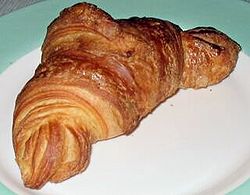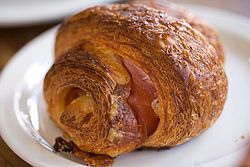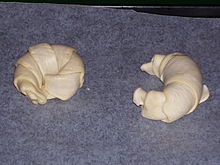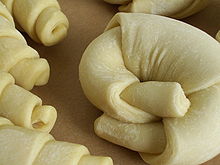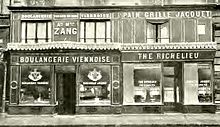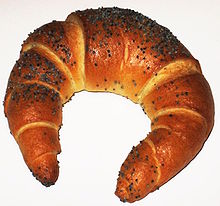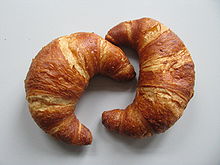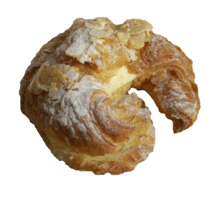- Croissant
-
A croissant (French pronunciation: [kʁwasɑ̃] (
 listen), anglicised variously as /krəˈsɑːnt/, /kwɑːˈsɑːn/, etc.) is a buttery flaky pastry named for its distinctive crescent shape. It is also sometimes called a crescent[1]. Croissants are made of a leavened variant of puff pastry. The yeast dough is layered with butter, rolled and folded several times in succession, then rolled into a sheet, a technique called laminating.
listen), anglicised variously as /krəˈsɑːnt/, /kwɑːˈsɑːn/, etc.) is a buttery flaky pastry named for its distinctive crescent shape. It is also sometimes called a crescent[1]. Croissants are made of a leavened variant of puff pastry. The yeast dough is layered with butter, rolled and folded several times in succession, then rolled into a sheet, a technique called laminating.Crescent-shaped food breads have been made since the Middle Ages, and crescent-shaped cakes (imitating the often-worshiped Moon) possibly since classical times,[2] but the modern croissant dates to 19th-century Paris.
Croissants have long been a staple of French bakeries and pâtisseries. In the late 1970s, the development of factory-made, frozen, pre-formed but unbaked dough made them into a fast food which can be freshly baked by unskilled labor. Indeed, the croissanterie was explicitly a French response to American-style fast food,[3] and today 30–40% of the croissants sold in French bakeries and patisseries are frozen.[4]
This innovation, along with the croissant's versatility and distinctive shape, has made it the best-known type of French pastry in much of the world. Today, the croissant remains popular in a continental breakfast.
Contents
Origin
The Kipferl – ancestor of the croissant – has been documented in Austria going back at least as far as the 13th century, in various shapes.[5] The Kipferl can be made plain or with nut or other fillings (some consider the rugelach a form of Kipferl).
The "birth" of the croissant itself – that is, its adaptation from the plainer form of Kipferl, before its subsequent evolution (to a puff pastry) – can be dated with some precision to at latest 1839 (some say 1838), when an Austrian artillery officer, August Zang, founded a Viennese Bakery ("Boulangerie Viennoise") at 92, rue de Richelieu in Paris.[6] This bakery, which served Viennese specialities including the Kipferl and the Vienna loaf, quickly became popular and inspired French imitators (and the concept, if not the term, viennoiserie, a 20th century term for supposedly Vienna-style pastries). The French version of the Kipferl was named for its crescent (croissant) shape.
Alan Davidson, editor of the Oxford Companion to Food, found no printed recipe for the present-day croissant in any French recipe book before the early 20th century; the earliest French reference to a croissant he found was among the "fantasy or luxury breads" in Payen's Des substances alimentaires, 1853. However, early recipes for the croissant (without butter, and so not puff pastry-based) can be found in the nineteenth century and at least one reference to croissants as an established French bread appeared as early as 1850.[7]
August Zang himself returned to Austria in 1848 to become a press magnate, but the bakery remained popular for some time after, and was mentioned in several works of the time: "This same M. Zank [sic]...founded around 1830 [sic], in Paris, the famous Boulangerie viennoise".[8] Several sources praise this bakery's products: "Paris is of exquisite delicacy; and, in particular, the succulent products of the Boulangerie Viennoise";[9] "which seemed to us as fine as if it came from the Viennese bakery on the rue de Richelieu".[10]
By 1869, the croissant was well established enough to be mentioned as a breakfast staple,[11] and in 1872, Charles Dickens wrote (in his periodical "All the Year Round") of:
the workman's pain de ménage and the soldier's pain de munition, to the dainty croissant on the boudoir table[12]
The puff pastry used to make the modern croissant was already mentioned in the late 17th century, when La Varenne's Le Cuisinier françois gave a recipe for it in the 1680 – and possibly earlier – editions. It was typically used, not on its own, but for shells holding other ingredients (as in a vol-au-vent). But it does not appear to be mentioned in relation to the croissant until the twentieth century.
Origin stories
Fanciful stories of how the Kipferl—and so, ultimately, the croissant—was created are widespread and persistent culinary legends, at least one going back to the 19th century.[13] However, there are no contemporary sources for any of these stories, nor does an aristocratic writer, writing in 1799, mention the pastry in a long and extensive list of breakfast foods.[14]
The legends include tales that it was invented in Europe to celebrate the defeat of the Umayyad forces at the Battle of Tours by the Franks in 732, with the shape representing the Islamic crescent;[15] that it was invented in Vienna in 1683 to celebrate the defeat of the Ottomans by Polish forces in the siege of the city, as a reference to the crescents on the Ottoman flags, when bakers staying up all night heard the tunneling operation and gave the alarm;[13] tales linking croissants with the kifli and the siege of Buda in 1686;[citation needed] and those describing mariantonietta hankering after a Polish specialty.[citation needed]
Variants
Croissant pastry can also be wrapped around any praline, almond paste or chocolate before it is baked (in the last case, it becomes like pain au chocolat, which has a different, non-crescent, shape), or sliced to admit sweet or savoury fillings. In France and Spain, croissants are generally sold without filling and eaten without added butter, but sometimes with almond filling. In the United States, sweet fillings or toppings are common, and warm croissants may be filled with ham and cheese or feta cheese and spinach. In the Levant, croissants are sold plain or filled with chocolate, cheese, almonds, or zaatar. In Germany, croissants are sometimes filled with Nutella or persipan; in Southern Germany there also is a popular variety of a croissant glazed with lye ("Laugencroissant"). In the German speaking part of Switzerland, the croissant is typically called a Gipfeli, which typically has a crisper crust and is less buttery than the French style croissant. In some Latin American countries, croissants are commonly served alongside coffee as a breakfast or merienda. These croissant are referred to as medialunas ("half moons") and are typically coated with a sweet glaze ("de manteca", made with butter). Another variant is a medialuna "de grasa" ("of lard"), which is not sweet. In Japan, croissants covered with a sweet glaze or filled with chocolate are common in bakeries and convenience stores.
Italy
A cousin of the croissant is the Italian pastry named "cornetto" in the Center and South and "brioche" in the North. Though the two pastries are often considered to be the same, that is not completely true: the French version of the croissant tends to be crispy and contains a lot of butter, whereas an Italian cornetto or brioche is usually softer. Furthermore, the "cornetto vuoto" (Italian: "empty cornetto") is commonly sided by variants with filling, which include "crema pasticcera", jam and chocolate cream. They often come covered with powder sugar.
Poland
St. Martin's Day is celebrated in the Greater Poland region of Poland, mainly in its capital city Poznań. On this day, the people of Poznań buy and eat considerable amounts of croissants, made specially for this occasion from half-French paste with white-poppy and dainties, so-called Martin Croissants or St. Martin Croissants.
Spread of the croissant
Historically, the croissant was not commonplace in the UK. Although available in specialty places,[clarification needed] it was only in the late 1980s that supermarkets started stocking them and then in the late 1990s with the growth of cafe culture did the croissant spread.[citation needed] They were introduced to Ethiopia by 1902, during the reign of Menelik II.[16]
Croissants are also seen in former French colonies such as Morocco and Vietnam where in the latter they are called bánh sừng bò.
Notes
- ^ Oxford English Dictionary, s.v. crescent.
- ^ "Qu'est-ce que la Bible? d'après la nouvelle philosophie allemande", translated by August Hermann Ewerbeck. 1850. p. 327. "Hebrew women, in the time of Jeremiah, made in honor of the pagan goddess Astarte (queen of heaven, queen of the moon) cakes, probably in the form of a crescent."
- ^ "Croissant Vite", Time 8 September 1980
- ^ Bertrand Rothé, "Il est bon mon croissant (surgelé)", Bakchich Info, 11 March 2008 [1]
- ^ Jacob Grimm and Wilhelm Grimm, Deutsches Wörterbuch von Jacob Grimm und Wilhelm Grimm 11
- ^ The 1839 date, and most of what follows, is documented in Jim Chevallier, "August Zang and the French Croissant: How Viennoiserie Came to France", p. 3-30; for the 1838 date, see Giles MacDonogh "Reflections on the Third Meditation of La Physiologie du goût and Slow Food" (p. 8); an Austrian PowerPoint – Ess-Stile – gives the date of 1840 (slide 46). A 1909 image of the bakery shows the same date for its founding, but the bakery was already documented in the press before that.
- ^ Académie d'agriculture de France, Mémoires (Paris: Bouchard-Huzard, 1850) First Part, p. 588)
- ^ "Revue Moderne" or "Revue Germanique", 1861, p. 80
- ^ Chambers' Edinburgh Journal, 1847, p. 254.
- ^ Théophile Gautier, "Voyage en Russie", Charpentier, 1867, p.188
- ^ "Nouvelle revue théologique", Casterman, 1869, p. 161
- ^ "The Cupboard papers: VIII. The Sweet Art", November 30, 1872
- ^ a b Karl August Schimmer, The Sieges of Vienna by the Turks: Translated from the German of Karl August Schimmer and Others, trans. Earl of Francis Egerton Ellesmere (London: John Murray, 1879), p. 30-31
- ^ Mme. de Genlis, "Manuel de Voyage", Berlin, P. T. de Lagarde, 1799, pp. 54–56.
- ^ "Gastronomic curiosities" (in portuguese). Editora Abril. http://historia.abril.uol.com.br/alimentacao/conteudo_553886.shtml. Retrieved 2009-05-03.
- ^ Chris Prouty, Empress Taytu and Menelik II: Ethiopia 1883–1910 (Trenton, NJ: Red Sea Press, 1986) pp.238–9
References
External links
 Media related to Croissant at Wikimedia Commons
Media related to Croissant at Wikimedia CommonsBaked goods depicting religious iconography hey
Categories:- Breakfast foods
- French loanwords
- French pastry
- Foods featuring butter
Wikimedia Foundation. 2010.

